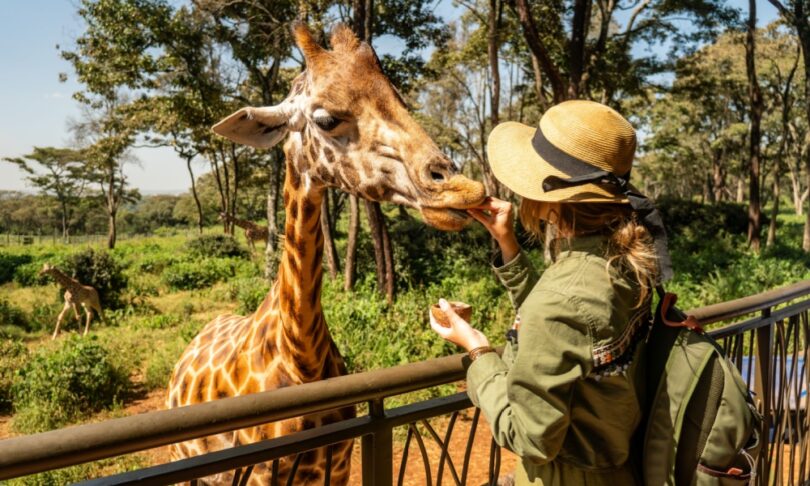In some of the world’s most innovative wildlife parks, the animals don’t just live — they roam. There are no cold bars or glass partitions here. Instead, you’ll find sweeping savannas, dense forests, and carefully designed habitats where lions lounge under the sun and giraffes saunter just beyond your path. These cageless zoos are rewriting the rules of animal encounters — and redefining what a trip to the zoo can be.
From open-air safaris to walk-through wildlife zones, these cageless zoos offer something way beyond the ordinary. Grab your camera, keep your hands inside the vehicle, and get ready to experience the wild without the walls.
Givskud Zoo — Denmark

Givskud Zoo 2010 by Klaus Sparre licensed under CC BY-SA 2.0
If you’re up for seeing the wild side of Denmark, then Givskud Zoo is one spot you don’t want to miss. This isn’t your average zoo experience — with a layout that blends drive-through safari zones and walkable paths, the park offers a front-row seat to animals roaming in open habitats. Lions, zebras, bison, and antelope move freely across wide spaces while you cruise through in your own car. There are no cages crowding the view — just a safe, smart setup that makes it feel like you’re drifting through the African plains…except in Denmark.
Once you’ve finished the drive, step out and explore the rest of the zoo on foot. Walking routes take you past even more environments featuring gorillas, elephants, and penguins — all housed in large, well-thought-out spaces that allow for plenty of movement. Bonus: the park’s dinosaur forest adds a fun twist for families, making it feel more like a full-day expedition than a stop-and-go photo op.
San Diego Safari Park — California

San Diego Safari Park by Carodean Road Designs licensed under CC by 2.0
Located in sunny Southern California, the San Diego Safari Park is like the Hollywood blockbuster of zoo experiences. The park sprawls across roughly 1,800 acres, making it significantly larger than its famous sibling, the San Diego Zoo. What sets this place apart is its naturalistic approach to animal habitats. You won’t find pens or tiny enclosures here. Instead, you get to watch rhinos, antelope, and giraffes roam freely in massive mixed-species savanna habitats that look straight out of Kenya.
When you hop on one of the safari-style tours — ranging from open-air trams to behind-the-scenes truck rides — you’re catching these animals in action. And if you’re into thrills? There’s even a zip-line experience that soars over the animal enclosures. It’s like flying above the Serengeti, but with distinctly fewer vaccinations and far better Wi-Fi.
Longleat Safari Park — Wiltshire, The United Kingdom

Longleat Safari Park Giraffe by Michael Gaylard licensed under CC by 2.0
Get ready to be wowed with some old-school British charm mixed with raw, untamed nature — because Longleat Safari Park is not your average U.K. attraction. Set on the grounds of a 16th-century stately home, Longleat is the original safari park gamechanger in the United Kingdom, opening its gates way back in 1966. It wasn’t just historic — it was revolutionary, bringing African savannas to the English countryside. And you get to experience it all from the comfort of your car as you drive through the enclosures, cruising past lions, elephants, and monkeys like you’re in a nature documentary — but with British GPS and possibly a tea flask rolling around your backseat.
The drive-through format at Longleat adds a dose of autonomy and thrill to your visit. There’s something heart-thumpingly magical about watching a pride of lions cross the path right in front of your own vehicle. While you control the pace of your journey, it’s the animals that call the shots. Every loop you take through Longleat could be completely different from the last, based entirely on where the lions nap, where the wolves wander, and how curious the giraffes are feeling that day.
Sabi Sands Game Reserve — South Africa

Nyala, Idube, Sabi Sands by flowcomm licensed under CC by 2.0
Say goodbye to fences entirely and hello to raw, unfiltered wilderness at Sabi Sands Game Reserve in South Africa. Unlike a traditional zoo or safari park, Sabi Sands isn’t just open — it’s wide open, wild, and teeming with the kind of wildlife encounters that make your heart race in the very best way. Bordering the legendary Kruger National Park with no fences between them, Sabi Sands is a private reserve where the animals roam freely, predators and prey alike. So keep those camera batteries charged and your eyes peeled.
What really makes Sabi Sands something else is the level of access and intimacy. You’re not stuck on big buses or viewing animals from a distance. Experienced guides and trackers take small groups out on game drives in open vehicles, often leading you right up to a leopard snoozing under a tree or a herd of elephants quenching their thirst at a watering hole. If you’ve ever wanted to see the Big Five in their natural habitat while sipping your morning coffee in an eco-lodge, Sabi Sands makes that wild fantasy a perfectly normal Tuesday.
Singapore Zoo

Singapore Zoo by Nigel Swales licensed under CC BY-SA 2.0
The Singapore Zoo is a place where you can almost forget you’re in a city-state surrounded by skyscrapers and shopping malls — because suddenly, you’re standing in front of a moat-separated orangutan habitat, where it feels like you’re eavesdropping on a jungle conversation. This world-famous zoo has earned its stripes (and then some) for its “open concept” design — meaning animals live in barrier-free spaces wherever possible, separated from the walking paths by cleverly engineered moats or natural landscaping instead of steel cages. It’s basically like someone handed a team of biologists a chunk of rainforest and said, “Go nuts.”
From orangutans swinging freely above the trails to immersive experiences like the Fragile Forest biodome, every corner of the Singapore Zoo is cinematic in the best way. You’ll spot beautifully integrated habitats that mimic the terrain of the species’ natural homes in Singapore, plus a heavy emphasis on conservation and education without ever feeling like a lecture. Want to dine while giraffes curiously peer across at you? Breakfast with the orangutans is a real thing, and it’s as charming as it sounds. This is one zoo that seriously raises the bar — and then swings from it, Tarzan-style.
Bioparc Valencia — Spain

Bioparc Valencia by williamwheatley licensed under PDM 1.0
Spain’s Bioparc Valencia is like stepping through a teleport into the wild terrains of Africa — without ever boarding a long-haul flight. This zoo pulls off something seriously special: it gets visitors as close to animals as possible without compromising safety or ethics. Their secret sauce? A philosophy called “zoo-immersion.” That means you’re not just looking at animals — you’re stepping into their world.
Animals are separated from paths by camouflaged trenches or water features so that, at times, it feels like there’s nothing between you and a towering giraffe or sauntering lemur, except your own pulse pounding with excitement. Bioparc is segmented into ecosystems rather than “animal zones,” so you wander through the savannas, Madagascar forests, and equatorial Africa in smooth, cinematic transitions. Watching hippos wade in a crystal-clear habitat or observing a gorilla family lounging in the afternoon shade is so stunningly real that your inner photographer will basically never want to put the camera down.
RELATED: Critters Down Under: Discovering Australia’s Most Iconic Animals
Beekse Bergen Safari Park — The Netherlands

beekse bergen (183) by bert knottenbeld licensed under CC BY-SA 2.0
Last but certainly not least, let’s head to the heart of the Netherlands for Beekse Bergen Safari Park. Here, you get options: explore by car, hop a guided bus tour, glide across the lake by boat, or even take a long stroll on foot. However you choose to roll, the experience wraps you in sweeping views and wide-open animal habitats that feel as freeing as they are photogenic. Lions, cheetahs, rhinos, and more all have room to roam, and watching them do so while you’re bobbing along on a boat is equal parts serene and surreal.
Beekse Bergen has mastered the art of blending education with entertainment. The park’s naturalistic design is big on space and low on barriers, pulling you into a sense of safari-style exploration from the first giraffe sighting to the last zebra crossing. If you’re traveling with kids — or let’s be real, just young at heart — there’s enough variety to keep everyone blissfully curious. And honestly, who doesn’t want to end a trip with a lakeside view and a lion lounging somewhere in the distance?
FAQs:
Q: What’s a good time of year to visit these cageless zoos and parks?
A: Spring and fall are usually ideal — milder weather means more active animals and fewer crowds. In Africa, go during dry season (May to September) for better wildlife spotting. Winter is great for snowy scenes at places like Parc Omega but might limit availability elsewhere.
Q: Do I need to book tickets in advance?
A: Yes, it’s a good idea — especially for guided tours, animal encounters, or parks with timed entry. Some locations even offer better rates for booking online ahead of time.
Q: Are these zoos and safari parks kid-friendly?
A: Absolutely. Most offer activities, special programs, or educational experiences for kids. Just double-check age guidelines for safari vehicles or close animal encounters, as some have minimum age restrictions.
Q: Can I bring my own food or snacks?
A: It depends on the park. Some allow picnic areas, while others want you to use their on-site cafes. If you’re driving through with animal contact (like Parc Omega), outside food must be animal-safe.
Q: What should I wear during my visit?
A: Comfortable walking shoes, layers, and sun protection are key. In open vehicle safaris, a hat and sunglasses help. For parks with forested paths or wet zones, bring a lightweight rain jacket just in case.
Q: Is photography allowed in these cageless parks?
A: It depends on the park. If you’re able to take pictures, bring a zoom lens for wide-open spaces and follow all the rules — no flash around sensitive species, and keep your distance.
Have you ever braved one of these cageless zoos? Tell us all about your experience in the comment section below!








